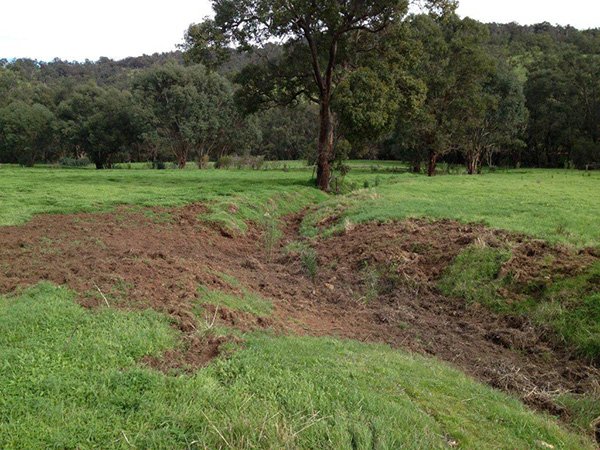Eradication of feral animals in the pipeline
Since colonisation, feral animals have had a significant negative impact on Australia’s biodiversity and natural environment.
According to the New South Wales Natural Resource Commission, their impact costs Australian farmers almost $800 million a year.

Damage caused by the feral pigs.
Pests such as cats, feral pigs, foxes and rabbits have been especially destructive on native wildlife, natural habitats, crops and livestock.
Australian Gas Infrastructure Group (AGIG), owner and operator of Dampier to Bunbury Pipeline (DBP), recognise the enormous threat these animals present and are on a mission to help eradicate feral animals across Western Australia.
In partnership with Landcare Australia, AGIG has contributed $30,000 to fund four projects that are controlling feral animals in the Pilbara, Mid West, Wheatbelt and Peel regions.
Managed by local Landcare and community groups, the projects are helping protect hundreds of threatened and endangered native species, safeguarding the productivity of farmers, and training local and Indigenous landowners to manage pests.
AGIG recognises the devastating impact feral animals have on the communities which the Dampier Bunbury Pipeline runs through.
According to Andrew Staniford, AGIG general manager of customer and shared services, supporting local communities where AGIG operates is very important.
“The Dampier Bunbury Pipeline spans almost the entire length of Western Australia. Unfortunately, the impact feral animals have on our state is not something isolated to one or two towns,” Andrew said.
“We know that supporting Landcare Australia through the funding of these four projects, we are taking direct action to stop this enormous problem.”
For the past six years, Chittering Landcare Group has been working in the Wheatbelt to control feral pigs in their local area.
Group Coordinator Rosanna Hindmarsh has experienced first-hand the damage caused by feral pigs.
“They destroy everything in their path,” Rosanna said.
“During the night they plough up paddocks and the national parks and reserves looking for yams. Orchard irrigation is ripped up in search of water and fences are broken creating major problems for farmers.”
Last year the group captured 168 pigs. The process is slow, often taking weeks from first sighting to capture. However, with a sow being able to produce 10 to 16 babies each year, every capture is another step closer to eradication.
AGIG’s funding was very timely for the group last year.
“A landowner approached us in August 2017 with a feral pig issue,” said Rosanna.
“AGIG’s grant was an important contribution as we had reached the end of a project and were waiting for funding to come through in 2018. The timing of the grant from AGIG meant we could immediately deal with the landowner’s problem.”
Over the course of four weeks the group capture 32 pigs – including 14 unborns – on three different locations, with the help of a professional trapper.
“In our opinion, the best way to tackle this issue is to seek and destroy,” said Rosanna. “Thanks to the timely support of AGIG that’s what we’ve been able to do.”
For more information on Landcare Australia’s partnership with DBP, visit landcareaustralia.org.au/our-partners/corporate-partners/dbp.



